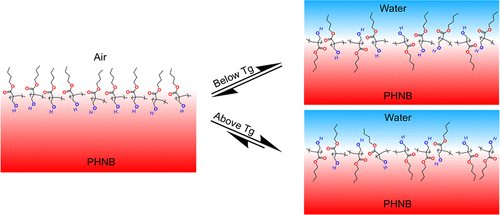当前位置:
X-MOL 学术
›
Macromolecules
›
论文详情
Our official English website, www.x-mol.net, welcomes your
feedback! (Note: you will need to create a separate account there.)
Reorganization of an Amphiphilic Glassy Polymer Surface in Contact with Water Probed by Contact Angle and Sum Frequency Generation Spectroscopy
Macromolecules ( IF 5.1 ) Pub Date : 2018-07-03 00:00:00 , DOI: 10.1021/acs.macromol.8b00640 Nishad Dhopatkar 1 , Emmanuel Anim-Danso 1 , Chao Peng 1 , Saranshu Singla 1 , Xinhao Liu 1 , Abraham Joy 1 , Ali Dhinojwala 1
Macromolecules ( IF 5.1 ) Pub Date : 2018-07-03 00:00:00 , DOI: 10.1021/acs.macromol.8b00640 Nishad Dhopatkar 1 , Emmanuel Anim-Danso 1 , Chao Peng 1 , Saranshu Singla 1 , Xinhao Liu 1 , Abraham Joy 1 , Ali Dhinojwala 1
Affiliation

|
We address the question of how a surface of a glassy polymer reorganizes after coming in contact with water. Because contact angle hysteresis measurements are also affected by surface roughness and chemical heterogeneity, we have used surface-sensitive sum frequency generation spectroscopy (SFG) in conjunction with water contact angles to answer this question. To increase the magnitude of the surface reorganization, we have designed an amphiphilic polymer, poly(α-hydroxymethyl-n-butyl acrylate) (PHNB), to study the changes in the structure of polar hydroxy groups and nonpolar (methyl and methylene) groups at the interface. The SFG and the water contact angles show that reorganization does occur for PHNB below Tg. However, complete reorganization requires heating the sample above the bulk Tg. These heating experiments were conducted by first heating the sample in the presence of water and then followed by cooling the sample to room temperature in the presence of water to lock the changes in the surface structure (we refer to this treatment as water annealing). The polar contribution to the total surface energy of PHNB, determined by Owens–Wendt–Rabel–Kaelble (OWRK) method at room temperature, increases after water annealing above Tg. This is consistent with our SFG results that show an increase in concentration of polar hydroxy groups at room temperature after water annealing the PHNB film above Tg. For PHNB, the contact angle hysteresis is higher for samples that are water annealed above Tg. This is consistent with the surface energy and SFG results. For a low-Tg polymer, poly(n-butyl acrylate), which has the same nonpolar side group but lacks the hydroxyl group, surface reorganization takes place immediately after contact with water, and these changes are reversible.
中文翻译:

接触角和和频产生光谱探测与水接触的两亲性玻璃态聚合物表面
我们解决了与水接触后玻璃态聚合物表面如何重组的问题。由于接触角磁滞的测量值还受表面粗糙度和化学异质性的影响,因此我们结合水接触角使用了表面敏感的和频产生光谱(SFG)来回答这个问题。为了增加表面重组的程度,我们设计了一种两亲性聚合物聚(α-羟甲基-正丁基丙烯酸酯)(PHNB),以研究极性羟基和非极性(甲基和亚甲基)基团的结构变化在界面上。SFG和水接触角表明,PHNB低于T g时确实发生了重组。但是,要完全重组,需要将样品加热到高于体温T g的水平。通过首先在水存在下加热样品,然后在水存在下将样品冷却至室温以锁定表面结构的变化(我们将此处理称为水退火)来进行这些加热实验。通过Owens-Wendt-Rabel-Kaelble(OWRK)方法在室温下确定的对PHNB的总表面能的极性贡献在水退火至T g以上后增加。这与我们的SFG结果一致,SFG结果表明在室温下将PHNB薄膜在T g以上进行水退火后,室温下极性羟基的浓度增加。对于PHNB,水退火温度高于T g的样品的接触角磁滞较高。这与表面能和SFG结果一致。对于具有相同非极性侧基但缺少羟基的低T g聚合物聚丙烯酸正丁酯,与水接触后立即发生表面重组,并且这些变化是可逆的。
更新日期:2018-07-03
中文翻译:

接触角和和频产生光谱探测与水接触的两亲性玻璃态聚合物表面
我们解决了与水接触后玻璃态聚合物表面如何重组的问题。由于接触角磁滞的测量值还受表面粗糙度和化学异质性的影响,因此我们结合水接触角使用了表面敏感的和频产生光谱(SFG)来回答这个问题。为了增加表面重组的程度,我们设计了一种两亲性聚合物聚(α-羟甲基-正丁基丙烯酸酯)(PHNB),以研究极性羟基和非极性(甲基和亚甲基)基团的结构变化在界面上。SFG和水接触角表明,PHNB低于T g时确实发生了重组。但是,要完全重组,需要将样品加热到高于体温T g的水平。通过首先在水存在下加热样品,然后在水存在下将样品冷却至室温以锁定表面结构的变化(我们将此处理称为水退火)来进行这些加热实验。通过Owens-Wendt-Rabel-Kaelble(OWRK)方法在室温下确定的对PHNB的总表面能的极性贡献在水退火至T g以上后增加。这与我们的SFG结果一致,SFG结果表明在室温下将PHNB薄膜在T g以上进行水退火后,室温下极性羟基的浓度增加。对于PHNB,水退火温度高于T g的样品的接触角磁滞较高。这与表面能和SFG结果一致。对于具有相同非极性侧基但缺少羟基的低T g聚合物聚丙烯酸正丁酯,与水接触后立即发生表面重组,并且这些变化是可逆的。











































 京公网安备 11010802027423号
京公网安备 11010802027423号